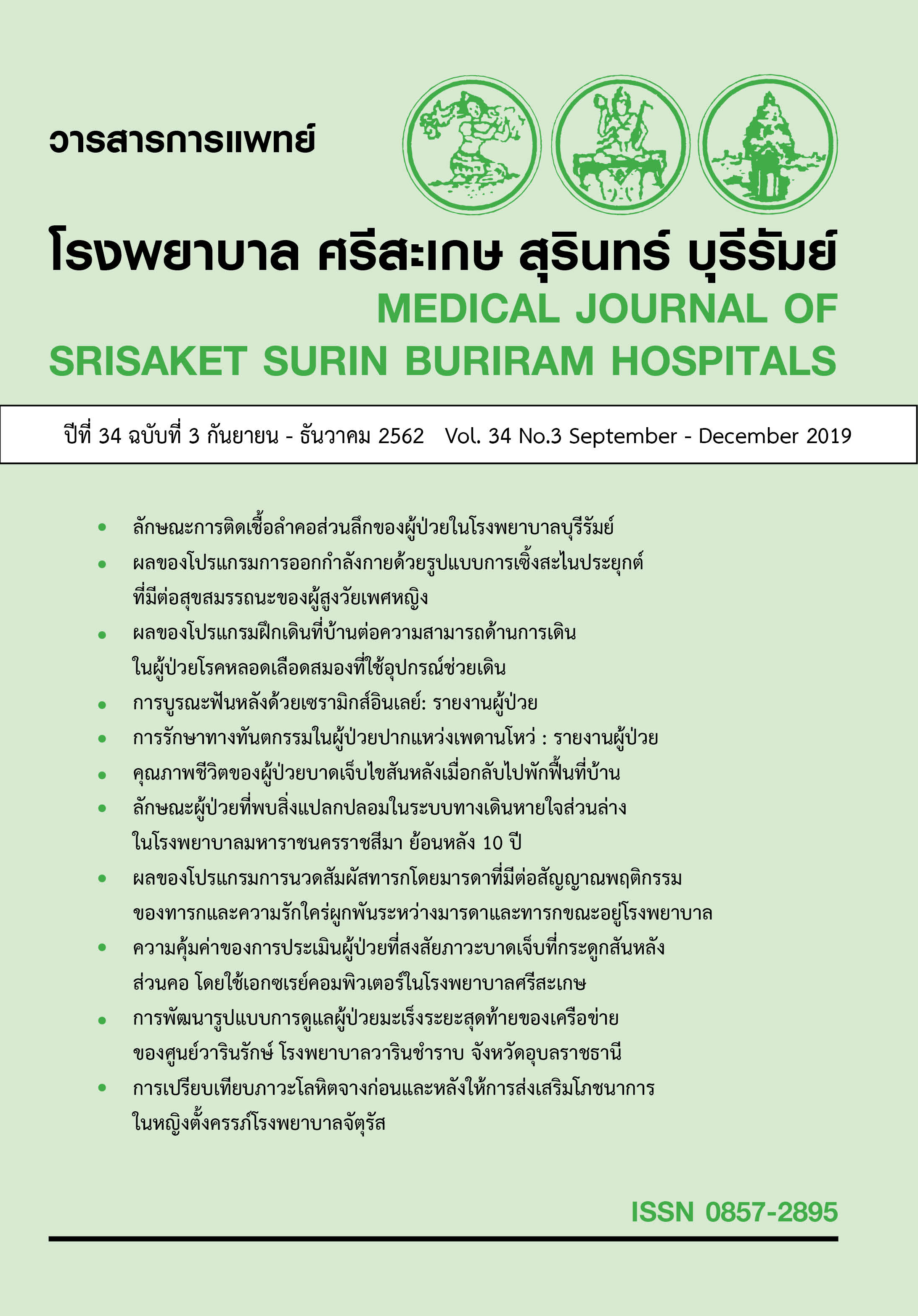การบูรณะฟันหลังด้วยเซรามิกส์อินเลย์: รายงานผู้ป่วย
Main Article Content
บทคัดย่อ
ในปัจจุบันผู้ป่วยมีความต้องการทางด้านความสวยงามมากขึ้น ทำให้เซรามิกส์ได้ถูกนำมาใช้ในทางทันตกรรม และจากการพัฒนาคุณสมบัติร่วมกับการใช้สารยึดติดที่มีประสิทธิภาพจึงได้มีการนำมาใช้ในการบูรณะบริเวณฟันหลังได้เป็นอย่างดีและเป็นที่นิยมมากขึ้นทันตแพทย์จึงควรทราบถึงข้อพิจารณาในการเลือกใช้และหลักการบูรณะฟันหลังด้วยเซรามิกส์ อินเลย์อย่างถูกต้อง เพื่อให้เกิดความสำเร็จของการรักษา
รายงานผู้ป่วยนี้ นำเสนอขั้นตอนทางคลินิกในการบูรณะฟันกรามบนซ้ายซี่ที่สองซึ่งถูกทำลายจากรอยโรคฟันผุ โดยมีขอบเขตครอบคลุมจากด้านบดเคี้ยวไปถึงด้านประชิดของฟัน ด้วยเซรามิกส์ อินเลย์ ชนิด lithium disilicate ( IPS e.max, IvoclarVivadent, Schaan,Liechtenstein) ซึ่งการบูรณะฟันด้วยเซรามิกส์ อินเลย์ เหมาะสำหรับฟันหลังที่มีขนาดโพรงฟันปานกลาง โดยสามารถแต่งรูปร่างฟันได้อย่างเหมาะสมและให้ความสวยงามที่ดี
คำสำคัญ: เซรามิกส์อินเลย์, การบูรณะฟัน, สิ่งบูรณะฟันโดยอ้อม
Article Details
เอกสารอ้างอิง
2. Kantorowice GF, Howe LC, Shortall AC. Inlays Crown & Bridge; A Clinical Handbook. 5th ed. Bristol: Wright; 1998.
3. spros A. Inlays & Onlays Clinical Experiences and Literature review. J Dent Health Oral Disord Ther 2015;2(1): 38-44.
4. Hopp CD, Land MF. Considerations for ceramic inlays in posterior teeth: a review. Clin Cosmet Investig Dent 2013;5:21-32.
5. Molin MK, Karlsson SL. A randomized 5-year clinical evaluation of 3 ceramic inlay systems. Int J Prosthodont 2000;13(3):194-200.
6. Hayashi M, Tsuchitani Y, Kawamura Y, Miura M, Takeshige F, Ebisu S. Eight-year clinical evaluation of fired ceramic inlays. Oper Dent 2000;25(6):473-81.
7. Stoll R, Cappel I, Jablonski-Momeni A, Pieper K, Stachniss V. Survival of inlays and partial crowns made of IPS empress after a 10-year observation period and in relation to various treatment parameters. Oper Dent 2007;32(6):556-63.
8. Thompson MC, Thompson KM, Swain M. The all-ceramic, inlay supported fixed partial denture. Part 1. Ceramic inlay preparation design: a literature review. Aust Dent J 2010;55(2):120-7.
9. Sorensen JA, Munksgaard EC. Relative gap formation of resin-cemented ceramic inlays and dentin bonding agents. J Prosthet Dent 1996;76(4):374-8.
10. Federlin M, Krifka S, Herpich M, Hiller KA, Schmalz G. Partial ceramic crowns: influence of ceramic thickness, preparation design and luting material on fracture resistance and marginal integrity in vitro. Oper Dent 2007;32(3):251-60.
11. Gemalmaz D, Ozcan M, Alkumru HN. A clinical evaluation of ceramic inlays bonded with different luting agents. J Adhes Den 2001;3(3):273-83.
12. Saridag S, Sevimay M, Pekkan G. Fracture resistance of teeth restored with all-ceramic inlays and onlays: an in vitro study. Oper Dent 2013;38(6):626-34.
13. Soares CJ, Martins LR, Pfeifer JM, Giannini M. Fracture resistance of teeth restored with indirect-composite and ceramic inlay systems. Quintessence Int 2004;35(4):281-6.
14. Bergman MA. The clinical performance of ceramic inlays: a review. Aust Dent J 1999;44(3):157-68.
15. al-Hiyasat AS, Saunders WP, Sharkey SW, Smith GM, Gilmour WH. Investigation of human enamel wear against four dental ceramics and gold. J Dent 1998;26(5-6):487-95.


